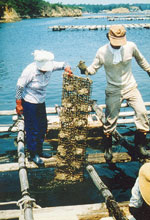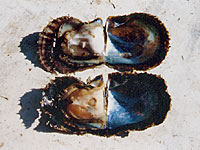Ocean Newsletter
No.86 March 5, 2004
-
Pearl culture and the biological environment
Shigeru Akamatsu Senior Counselor, Japan Pearl Promotion Society / Selected Papers No.6(p.19)
Japan dominated the world's cultured pearl industry as the suzerain state for a long time. However, the scheme has been collapsing in these days. Though the rapid globalization of the pearl industry can be considered as one of the reasons for that, the most dominant causes are the deterioration of the pearl farm environment caused by the occurrence of harmful red tide and massive mortality of Akoya pearl oysters due to infectious disease. Such a phenomenon is referred not only to pearl culture but also to BSE, carp herpes, avian influenza, etc. These phenomena may seem to be the retribution of not treating animals as living creature for the pursuit of economic efficiency and of incessant change of the natural environment for production increase.
Selected Papers No.6(p.19) -
Several problems in building a "floating-type sea fishing park"
Masayuki Yonezawa Formerly Deputy General Manager, Marine Engineering Group, Solution Engineering Center, JFE Engineering Corporation (currently working for JFE KANKYO Corporation)
A floating structure is viewed as a "moored vessel" by the Maritime Bureau of the Ministry of Land, Infrastructure and Transport (MLIT) in Japan from the viewpoint of vessels, while it is viewed as a "facility of a port" by the Ports and Harbors Bureau, and as a "marine structure" by the Housing Bureau of MLIT, noting its similarities in usage with a structure on land. That is to say, for the safety of the structure, application of the Law for Safety of Vessels, the Port Act and the Building Standard Law (including the Fire Service Law) are required under each system of law, respectively. However, the present two cases are exempt from the application of these laws. It is hoped that various systems of laws and regulations would be a chance rather than an obstacle, for the facilitation of new and positive utilization of sea areas in the future.
-
Sakhalin oil and gas development and its influence on oceans around Japan
Seiu Takada Director, Tufted Puffin Office
Oil and gas development projects in Sakhalin Island are being performed. However, are analyses of the damage risks and anti-disaster measures for the occurrence of oil spill accidents being sufficiently performed? Development of energy resources in the sea around Hokkaido is an enterprise promising for Japan's economy and energy security in the future, however, there is concern about the progress of the development with lack of consideration for the rich national environment.
Pearl culture and the biological environment
Japan dominated the world's cultured pearl industry for many years, but in recent times that state of affairs is changing rapidly. Though the rapid globalization of the pearl industry can be considered as one of the reasons, the primary cause is the deterioration of pearl farms caused by the occurrence of harmful red tides and the massive mortality of Akoya pearl oysters due to an infectious disease. Such phenomena relate not only to pearl culture, but also to BSE, carp herpes, avian influenza, etc., and may be the price paid for not treating animals as living creatures, in the pursuit of economic efficiency, as well as for incessantly changing the natural environment for the expansion of production.
Japan has long dominated the world's cultured pearl industry since pearl farming technology was developed some 110 years ago. However, this dominance is being undermined as the quantity and quality of cultured pearls produced in China, Indonesia, the Philippines, Australia, and Tahiti increases along with the globalization of pearl culture. There is also another reason that should not be overlooked: the drastic decline of Japan's own pearl industry. This relates to man-made disasters caused by the deterioration of pearl farms and the massive mortality of Akoya pearl oysters due to infectious disease. These phenomena may be the price paid for not treating animals as living creatures, in the pursuit of economic efficiency, as well as for incessantly changing the natural environment for the expansion of production. On this occasion therefore, I would like mainly to discuss pearl culture and the biological environment.
1. The present status and problems of cultured pearls
 Akoya pearl oysters are put into a nylon net for cultivation. Pearl farming in the sea must respond promptly and precisely to everchanging sea conditions that include typhoons, red tides and low temperatures in winter.(Photo: Japan Pearl Exporters'Association)
Akoya pearl oysters are put into a nylon net for cultivation. Pearl farming in the sea must respond promptly and precisely to everchanging sea conditions that include typhoons, red tides and low temperatures in winter.(Photo: Japan Pearl Exporters'Association)
 A healthy Akoya pearl oyster (above) and an infected Akoya pearl oyster (below): The ligament of the infected Akoya pearl oyster (below) changed its color into reddish brown. Soon the whole muscle will be damaged and the oyster will die. There were no effective countermeasures against this infectious disease, which occurred eight years ago, and so Japan's cultured pearl industry was decimated.
A healthy Akoya pearl oyster (above) and an infected Akoya pearl oyster (below): The ligament of the infected Akoya pearl oyster (below) changed its color into reddish brown. Soon the whole muscle will be damaged and the oyster will die. There were no effective countermeasures against this infectious disease, which occurred eight years ago, and so Japan's cultured pearl industry was decimated.
As mentioned above, pearl culturing technology developed approximately 110 years ago and eventually grew into an industry. In particular, after World War II, cultured pearls played an important role as export products that earned precious foreign currency. Before long, pearl culture spread to China, Australia and Tahiti, and due to its globalization intense competition began. As a result, Japan's freshwater pearls and black pearls were forced to withdraw from the market as they were exposed to intense global competition with China and Tahiti. Even Akoya pearls, which once dominated the world market, are now being threatened by the Chinese industry. To make matters worse, production dropped to one third of previous levels due to the massive mortality of Akoya pearl oysters in Japan, which continues due to the occurrence of harmful red tides and infectious disease. We now find ourselves as the world's greatest importer of pearls. It somehow seems that Japan's pearl industry has entered a period of decline, though more detailed analysis reveals common patterns in pearl history irrelevant to the types of Akoya pearl oysters or pearl farming areas. Whatever the circumstances, pearl culture undergoes technological invention, increased production due to technological innovation, quality degradation caused by deteriorated pearl farms and the massive mortality of Akoya pearl oysters, intensified global competition, and decline. At first, technology is invented and technological invention brings about an industry. When technological innovation occurs, production increases drastically and surpasses the production capabilities of pearl farms. Production continues to increase until reproduction becomes impossible. Akoya pearl oysters cultivated in pearl farms under such conditions will naturally become unsustainable because they are living creatures. As a result, harmful red tides that were never seen before suddenly occur, or a new disease that cannot be overcome breaks out. They result in abnormalities or the wiping out of Akoya pearl oysters and a situation where pearl farming cannot be performed on a continuous basis.
Infected Akoya pearl oysters develop a disease when water temperatures are high in summer, farming is con gested, or other stresses are added. They probably developed a disease on the last occasion when the resistance that had protected them in the past collapsed under the pressure of stresses being continuously added on a daily basis. This phenomenon has also occurred among other animals, like carp herpes that broke out in Kasumigaura. The case of Akoya pearl oysters being infected in Ehime strangely overlaps with that of carp contracting herpes in Kasumigaura. With respect to BSE, carp herpes, avian influenza and other present-day ubiquitous global problems, I can't help feeling that living creatures that have been forced to produce by humans have started to exact revenge on us. What do you think?
2. The future of pearl culture
There are several issues regarding the future of pearl culture. I would next like to outline three of them. The first issue is that the value of cultured pearls as jewels should be maintained. Unfortunately, due to the recent popularization of cultured pearls, there is a school of thought that "as long as they sell, anything will do". Once low-quality, lowpriced cultured pearls start selling, they will be mass-produced in the extreme without consideration for the natural environment or living creatures. The time has passed when pearl farms and Akoya pearl oysters were innumerable. It is necessary to use limited resources efficiently, and to switch to a system that produces cultures pearls of a high quality in small amounts.
The second issue is that the pearl industry should break away from "a labor-intensive industry" to "a technologyintensive industry." The industry's previous measures were utterly ineffective against the new infectious disease, so the delay in its initial response resulted in extensive damage. In the case of cows, carp, chickens, ducks, masked palm civets and any other animals, they are instantly disposed of when infected. Unfortunately, such a measure was not taken for pearl culture in the initial stage, so the infectious disease spread quickly across the country. In addition, many pearl cultivators imported a large amount of Akoya pearl oysters from China and cultivated hybrid Akoya pearl oysters crossed with Japanese Akoya pearl oysters because they heard a rumor that some Akoya pearl oysters from China had a strong resistance to infectious disease. Therefore, it is now feared that even pure Japanese Akoya pearl oysters may become extinct. It was discovered that our previous experience and instincts are totally useless for harmful red tides and infectious disease. Unless there is a shift to pearl culture backed by scientific methods, we will not be able to respond to unexpected incidents in the future. The third issue, "harmony between the pearl industry and ecosystems" is the most important. From now on, the industry should not simply be prioritized, but thought as to how consideration should be given to the environment becomes crucial. In practical terms, it is necessary to thoroughly manage pearl farms by accurately understanding their production capacity in order to avoid congestion, and by preventing the deterioration of pearl farms caused by the shortage of food and oxygen, as well as the generation of hydrogen sulfide. It is also necessary to scientifically understand changes in sea conditions and to establish a system for predicting red tides so as to prevent damage. As for Akoya pearl oysters, healthy Akoya pearl oysters should be produced. In order to do so, it is necessary to analyze superior Akoya pearl oysters at the genetic level, to store superior species with the use of frozen sperm and to establish technology for producing Akoya pearl oysters through hatchery system. It is also necessary to respond to infectious diseases promptly by prohibiting the import or by burning infected Akoya pearl oysters. Crossing with foreign species must be avoided, and as each pearl cultivator cannot respond to all of these issues independently, the local sector and unions should cooperate in addressing these issues.
Japan's pearl culture is now at a turning point. It may completely break away into a technology-intensive industry and make another leap forward, or it may keep its conventional methods, lose to global competition, and fall into decline.
